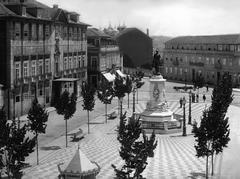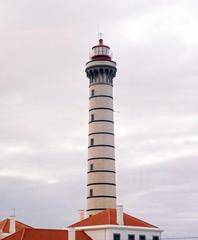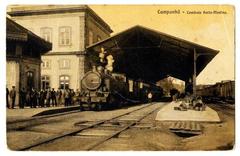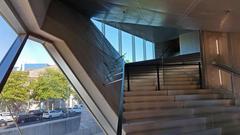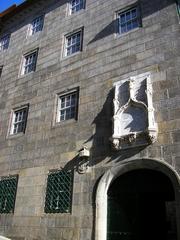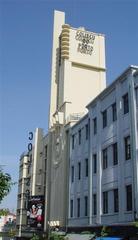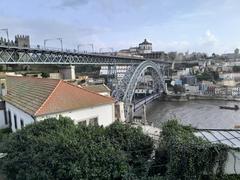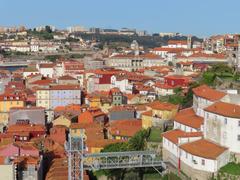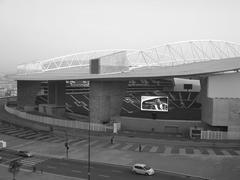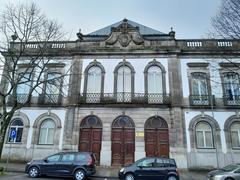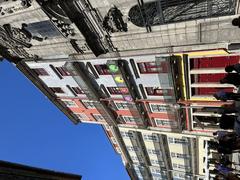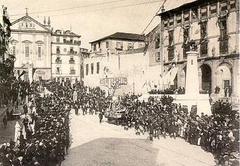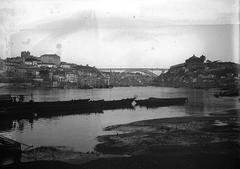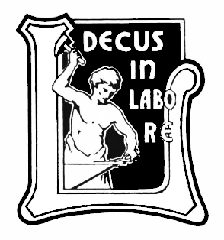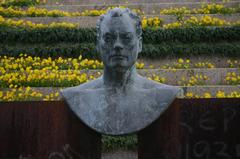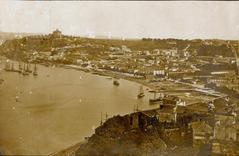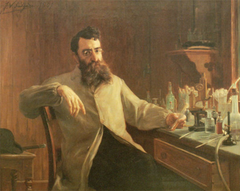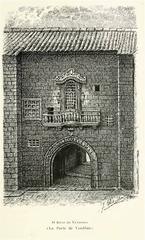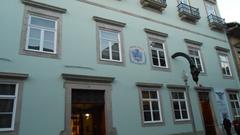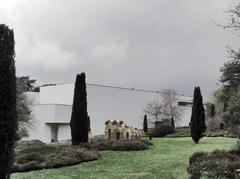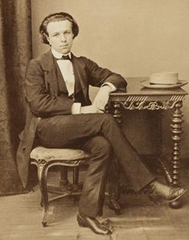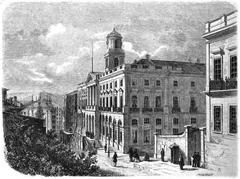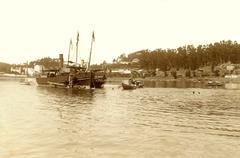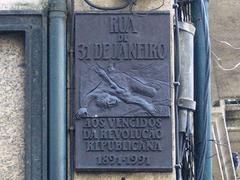Visiting Jardim do Passeio Alegre: Hours, Tickets, and Tips
Date: 17/07/2024
Introduction
Nestled in the scenic Foz do Douro district of Porto, Portugal, Jardim do Passeio Alegre is a historical garden that has been a cornerstone of the city’s cultural and social life since its inception in the 19th century. Designed by the German landscape architect Emile David in 1860, the garden was part of an extensive urban development initiative aimed at beautifying Porto’s coastal areas. Renowned for its eclectic blend of architectural marvels and botanical diversity, Jardim do Passeio Alegre features monumental obelisks from the 18th century, numerous exotic plant species, and a bandstand that has hosted countless musical performances over the centuries. This lush oasis not only offers a retreat from the bustling city but also serves as a vibrant cultural hub, making it a must-visit for both locals and tourists. (Porto Tourism)
Table of Contents
- Origins and Early Development
- Architectural and Botanical Features
- Cultural and Social Significance
- Historical Events and Milestones
- Preservation and Restoration Efforts
- Modern-Day Relevance
- Notable Monuments and Artworks
- Influence on Local Urban Development
- Educational and Research Opportunities
- Community Engagement and Volunteer Programs
- Visitor Information
- Future Prospects and Challenges
- FAQ
- Major Attractions
- Conclusion
Origins and Early Development
Jardim do Passeio Alegre, located in the Foz do Douro district of Porto, Portugal, is a historic garden that dates back to the 19th century. The garden was initially designed in 1860 by the German landscape architect Emile David, who was also responsible for the design of the Crystal Palace Gardens in Porto. The creation of Jardim do Passeio Alegre was part of a broader urban development plan aimed at enhancing the aesthetic and recreational appeal of the city’s coastal areas.
Architectural and Botanical Features
The garden is renowned for its eclectic mix of architectural and botanical elements. One of the most striking features is the set of two monumental obelisks at the entrance, which were originally part of the now-demolished São Francisco Convent. These obelisks, dating back to the 18th century, add a historical depth to the garden’s ambiance. The garden also boasts a variety of exotic plant species, including palm trees, magnolias, and camellias, which were imported from different parts of the world during the 19th century. This diverse flora not only enhances the garden’s beauty but also reflects the global botanical interests of that era.
Cultural and Social Significance
Jardim do Passeio Alegre has long been a social and cultural hub for the residents of Porto. In the late 19th and early 20th centuries, the garden was a popular meeting place for the city’s elite, who would gather for leisurely strolls and social events. The garden’s bandstand, built in 1883, has hosted numerous musical performances, contributing to the cultural life of the city. The bandstand remains a focal point for cultural activities, including concerts and public gatherings, making it a vital part of Porto’s social fabric.
Historical Events and Milestones
Over the years, Jardim do Passeio Alegre has witnessed several significant events. During the early 20th century, the garden was a site for various public celebrations and political rallies. One notable event was the visit of King Carlos I of Portugal in 1908, which was marked by grand festivities in the garden. The garden also played a role during the Portuguese Revolution of 1910, serving as a gathering point for political activists and revolutionaries.
Preservation and Restoration Efforts
In recent years, there have been concerted efforts to preserve and restore Jardim do Passeio Alegre to its former glory. The garden underwent a major restoration project in the early 2000s, which included the refurbishment of its historical structures and the replanting of its botanical collections. These efforts were aimed at maintaining the garden’s historical integrity while enhancing its appeal as a modern recreational space. The restoration project was supported by both the local government and private organizations, reflecting the community’s commitment to preserving this historic landmark.
Modern-Day Relevance
Today, Jardim do Passeio Alegre continues to be a beloved destination for both locals and tourists. The garden’s scenic beauty, combined with its rich history, makes it a unique attraction in Porto. It serves as a tranquil retreat from the bustling city, offering visitors a chance to relax and enjoy nature. The garden also hosts various cultural events throughout the year, including art exhibitions, music festivals, and community fairs, ensuring its continued relevance in the city’s cultural landscape.
Notable Monuments and Artworks
The garden is home to several notable monuments and artworks that add to its historical and cultural significance. One such monument is the statue of António Nobre, a famous Portuguese poet, which was erected in 1926. The statue, created by the sculptor Tomás Costa, is a tribute to Nobre’s contributions to Portuguese literature and his connection to the city of Porto. Another significant artwork is the “Fonte das Virtudes” (Fountain of Virtues), a beautiful marble fountain that dates back to the 18th century. These monuments not only enhance the garden’s aesthetic appeal but also serve as reminders of Porto’s rich cultural heritage.
Influence on Local Urban Development
Jardim do Passeio Alegre has also played a role in shaping the urban development of the Foz do Douro district. The garden’s establishment in the 19th century spurred the development of surrounding areas, leading to the construction of elegant villas and mansions that reflect the architectural styles of that period. The garden’s presence has also influenced the development of public spaces and recreational facilities in the district, contributing to the overall quality of life for its residents.
Educational and Research Opportunities
In addition to its recreational and cultural significance, Jardim do Passeio Alegre offers educational and research opportunities. The garden’s diverse plant collections provide a valuable resource for botanical studies and environmental education. Local schools and universities often organize field trips and research projects in the garden, allowing students to learn about plant biology, ecology, and conservation. The garden also collaborates with botanical institutions and environmental organizations to promote awareness and understanding of plant diversity and conservation.
Community Engagement and Volunteer Programs
Jardim do Passeio Alegre actively engages with the local community through various volunteer programs and initiatives. These programs encourage community members to participate in the maintenance and enhancement of the garden, fostering a sense of ownership and pride. Volunteers assist with tasks such as planting, pruning, and organizing events, contributing to the garden’s upkeep and vibrancy. The garden also hosts workshops and educational programs for children and adults, promoting environmental stewardship and community involvement.
Visitor Information
Visiting Hours
The garden is open daily from 8:00 AM to 8:00 PM.
Tickets
Entrance to Jardim do Passeio Alegre is free of charge.
Travel Tips
It is recommended to visit during the spring or summer months to fully enjoy the garden’s floral displays. Comfortable walking shoes are advised.
Nearby Attractions
Located near the garden are the Foz do Douro beaches, the Sea Life Porto aquarium, and the historic chapel of Senhor da Pedra.
Accessibility
The garden is wheelchair accessible, with paved paths and ramps.
Future Prospects and Challenges
Looking ahead, Jardim do Passeio Alegre faces both opportunities and challenges. The garden’s historical and cultural significance makes it a valuable asset for Porto, attracting visitors and contributing to the city’s tourism industry. However, maintaining the garden’s historical integrity and botanical diversity requires ongoing efforts and resources. Climate change, urban development, and budget constraints pose challenges to the garden’s preservation and sustainability. Addressing these challenges will require continued collaboration between the local government, community organizations, and private stakeholders to ensure that Jardim do Passeio Alegre remains a cherished and vibrant part of Porto’s heritage.
FAQ
Q - What are the visiting hours for Jardim do Passeio Alegre? A - The garden is open daily from 8:00 AM to 8:00 PM.
Q - Is there an entrance fee for Jardim do Passeio Alegre? A - No, entrance to Jardim do Passeio Alegre is free of charge.
Q - Are there guided tours available? A - Yes, guided tours can be arranged through the Porto Tourism office.
Q - What are some nearby attractions? A - Nearby attractions include the Foz do Douro beaches, the Sea Life Porto aquarium, and the historic chapel of Senhor da Pedra.
Q - Is the garden accessible for wheelchair users? A - Yes, the garden is wheelchair accessible with paved paths and ramps.
For more information on Jardim do Passeio Alegre, you can visit the official website of Porto Tourism.
Major Attractions in Jardim do Passeio Alegre
Fountain of the Lions
One of the most iconic features of Jardim do Passeio Alegre is the Fountain of the Lions. This stunning fountain, which dates back to the 19th century, is a central attraction within the garden. The fountain is adorned with four majestic lion statues, each spouting water into the basin below. The lions are crafted from granite, a material commonly used in Porto’s architecture, and they symbolize strength and power. The fountain is not only a beautiful piece of art but also a popular spot for visitors to relax and take photographs. (Porto Tourism)
Palm Tree Avenue
Palm Tree Avenue is another significant attraction within Jardim do Passeio Alegre. This picturesque pathway is lined with tall, elegant palm trees that create a tropical ambiance in the heart of Porto. The avenue is perfect for a leisurely stroll, offering shade and a serene environment. The palm trees were planted in the late 19th century, and they have since become a defining feature of the garden. Walking down Palm Tree Avenue, visitors can enjoy the lush greenery and the gentle rustling of the palm fronds in the breeze. (Porto City Hall)
Chapel of São João da Foz
Located within the garden, the Chapel of São João da Foz is a small but historically significant religious site. The chapel dates back to the 16th century and is dedicated to Saint John the Baptist. It features a simple yet charming architectural style, with a whitewashed exterior and a modest bell tower. The chapel is often open to visitors, allowing them to explore its interior and learn about its history. It is a peaceful place for reflection and offers a glimpse into the religious heritage of Porto. (Jardins do Porto)
Bandstand
The bandstand in Jardim do Passeio Alegre is a delightful structure that adds to the garden’s charm. Built in the early 20th century, the bandstand is an example of the ironwork architecture that was popular during that period. It is often used for musical performances and cultural events, making it a lively spot within the garden. The bandstand is surrounded by well-maintained flower beds and benches, providing a lovely setting for visitors to enjoy live music or simply relax. (Porto Events)
Children’s Playground
For families visiting Jardim do Passeio Alegre, the children’s playground is a major attraction. The playground is equipped with a variety of play structures, including swings, slides, and climbing frames, designed to entertain children of all ages. It is a safe and fun environment where kids can play and make new friends. The playground is located in a shaded area of the garden, ensuring that children can play comfortably even on hot days. Parents can relax on nearby benches while keeping an eye on their little ones. (Family Fun Porto)
Rose Garden
The Rose Garden is a beautiful and fragrant area within Jardim do Passeio Alegre. This section of the garden is dedicated to various species of roses, which bloom in a riot of colors during the spring and summer months. The Rose Garden is meticulously maintained, with well-defined pathways that allow visitors to stroll among the flowers and enjoy their scent. It is a popular spot for photography, especially during the peak blooming season. The Rose Garden also features informational plaques that provide details about the different types of roses on display. (Porto Gardens)
Sculptures and Monuments
Jardim do Passeio Alegre is home to several sculptures and monuments that add to its cultural and historical significance. One notable sculpture is the “Monument to the Heroes of the Peninsular War,” which commemorates the Portuguese soldiers who fought in the Peninsular War against Napoleon’s forces. The monument features a bronze statue of a soldier and is surrounded by beautifully landscaped gardens. Another significant sculpture is the “Statue of António Nobre,” a tribute to the famous Portuguese poet. These sculptures and monuments provide visitors with an opportunity to learn about Portugal’s history and cultural heritage. (Porto Monuments)
Café and Refreshment Kiosks
Scattered throughout Jardim do Passeio Alegre are several cafés and refreshment kiosks where visitors can enjoy a variety of snacks and beverages. These establishments offer a range of options, from traditional Portuguese pastries and coffee to ice cream and cold drinks. The outdoor seating areas provide a pleasant place to sit and enjoy a meal or a drink while taking in the garden’s beauty. The cafés and kiosks are conveniently located near major attractions within the garden, making them easily accessible for visitors. (Porto Dining)
Seasonal Events and Festivals
Jardim do Passeio Alegre hosts a variety of seasonal events and festivals throughout the year, making it a vibrant and dynamic destination. During the summer months, the garden often features open-air concerts, theater performances, and cultural festivals that attract both locals and tourists. One of the most popular events is the “Festa de São João,” a traditional festival celebrating Saint John the Baptist, which includes music, dancing, and fireworks. These events provide a unique opportunity to experience the local culture and enjoy the garden in a festive atmosphere. (Porto Festivals)
Botanical Diversity
The botanical diversity of Jardim do Passeio Alegre is one of its most appealing features. The garden is home to a wide variety of plant species, including exotic trees, flowering shrubs, and ornamental plants. Some of the notable species include magnolias, camellias, and azaleas, which add to the garden’s visual appeal. The diverse plant life attracts a variety of birds and butterflies, making it a haven for nature enthusiasts. Informational plaques throughout the garden provide details about the different plant species, enhancing the educational experience for visitors. (Porto Botany)
Conclusion
Jardim do Passeio Alegre stands as a testament to Porto’s rich cultural and historical heritage. With its diverse attractions ranging from the majestic Fountain of the Lions to the serene Chapel of São João da Foz, the garden offers a unique blend of natural beauty and historical significance. The ongoing preservation and restoration efforts underscore the community’s commitment to maintaining this historic landmark for future generations. As a beloved destination that continues to host cultural events, educational programs, and community initiatives, Jardim do Passeio Alegre remains a vital part of Porto’s social fabric. Whether you are a history enthusiast, a nature lover, or simply looking for a tranquil escape, a visit to Jardim do Passeio Alegre promises an enriching experience. For more information and updates, follow us on social media or download the Porto Tourism mobile app. (Porto City Hall)
References
- Porto Tourism (2024). Explore the Historic Jardim do Passeio Alegre in Porto - Visiting Hours, Tickets, and More. Porto Tourism
- Porto City Hall (2024). Exploring Jardim do Passeio Alegre - Major Attractions, History, and Visitor Tips. Porto City Hall
- Jardins do Porto (2024). Plan Your Visit - Jardim do Passeio Alegre in Porto - Tips, Hours, and Attractions. Jardins do Porto
